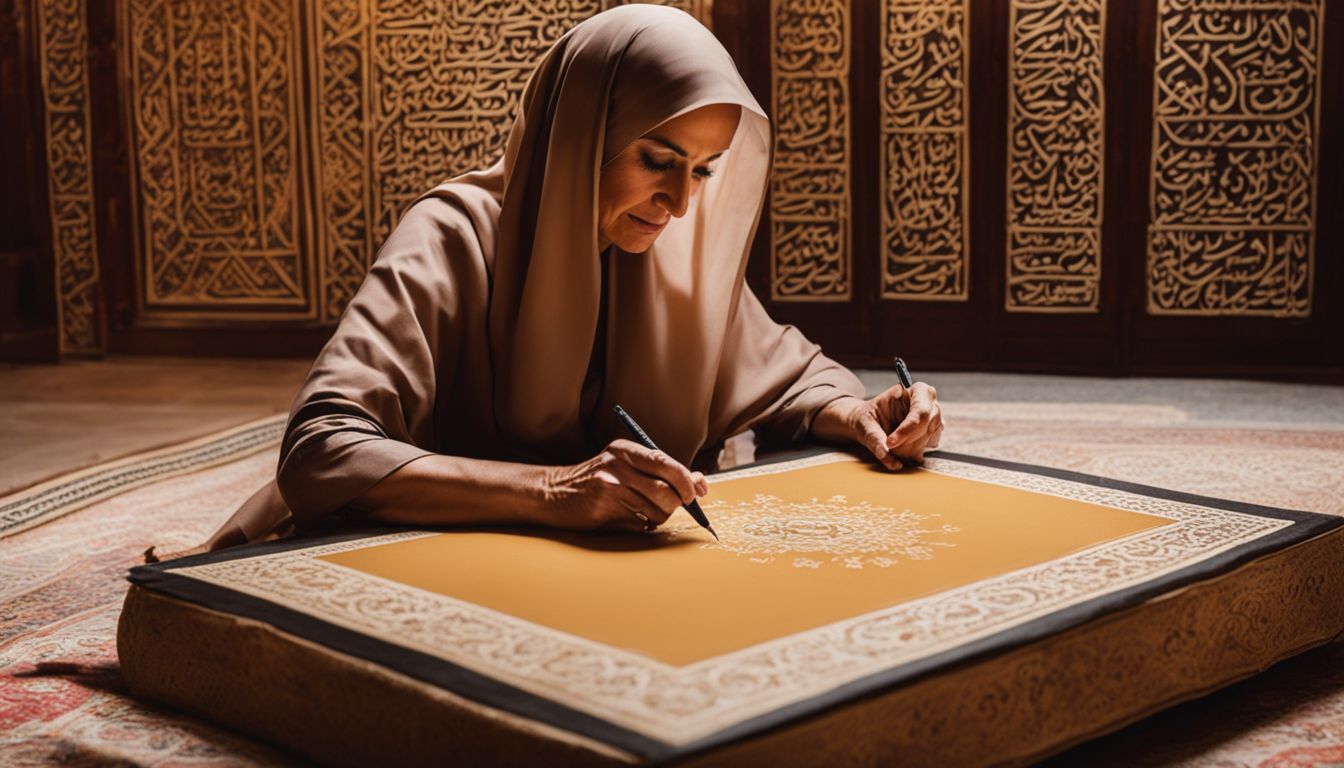Many people want to learn about calligraphy, especially when it involves unique names like Alexander. Arabic Thuluth calligraphy is a beautiful art form with deep roots. This blog will show you the beauty of “calligraphy Alexander” and how to appreciate its intricacies.
Get ready for an artistic journey!
The Significance of Thuluth Calligraphy in Arabic Script

Thuluth calligraphy holds a special place in Arabic script for its elegance and complexity. This style, often chosen for wedding invitations and religious texts, uses broad strokes that can turn any word into a work of art.
Artists use this technique to create webfonts that add a touch of tradition to modern applications, from mobile apps on iOS and Android platforms to desktop software like Microsoft Word and Adobe InDesign.
The way Thuluth blends with technology proves its adaptability and enduring appeal.
I had the chance to witness the beauty of Thuluth up close at an exhibition in Washington Cathedral back in 1979. It was mesmerizing seeing how each stroke conveyed so much emotion and depth, transforming simple letters into breathtaking pieces.
This experience showed me why Thuluth is more than just writing; it’s a bridge between past traditions and today’s digital world, making it as relevant on the screen as it is on paper.
Techniques Used in Crafting Alexander in Thuluth Style
Crafting Alexander in Thuluth style involves using specific tools and materials, employing precise strokes and flourishes, and mastering the art of holding a calligraphy pen. The process demands dedicated practice and attention to detail.
Choice of Tools and Materials
Selecting the right tools and materials is crucial for mastering Thuluth calligraphy, especially when writing names like Alexander. Artists need high-quality pens designed for Arabic script.
These pens come in different sizes to create thick and thin lines, essential for Thuluth’s elegant strokes. Ink quality also plays a vital role; it must flow smoothly without blotting or spreading unpredictably on paper.
For practicing or final presentations, choosing the correct paper type is key. Smooth, durable papers are preferred to withstand multiple ink layers without tearing. Some calligraphers use digital tablets for practice before moving onto traditional methods, offering a modern twist to this ancient art form.
Incorporating software like Photoshop allows for experimenting with small caps or adjusting serif styles easily. This combination of traditional craftsmanship and modern technology brings unique textures and depth to the art of calligraphy Alexander in Thuluth style.
Specific Strokes and Flourishes
Creating Alexander’s name in Arabic Thuluth calligraphy involves mastering specific strokes and flourishes. Each stroke adds beauty and uniqueness to the artwork, making it stand out. Here’s a detailed look into crafting these elements:
- Choose the Right Tools: Start with selecting a high-quality calligraphy pen designed for Thuluth script. The ink you use needs to flow smoothly to prevent any breaks in the strokes.
- Practice Neat Strokes: The art of Thuluth calligraphy demands neatness, especially when creating alternate lowercase letters in Alexandra Calligraphy. Each stroke must be precise to ensure clarity and aesthetic appeal.
- Incorporate Wind Theme Flourishes: Adding elements of the wind theme can bring a sense of movement to Alexander’s name. These flourishes mimic the flowing nature of air, providing a dynamic look to the piece.
- Apply Love Theme Accents: To infuse emotion into your work, incorporate flourishes from the love theme. These details add warmth and depth, making the piece more personal and engaging.
- Experiment with Dragon Theme Curves: For a more dramatic effect, try adding curves inspired by the dragon theme around Alexander’s name. This gives an exotic touch and highlights the strength of the script.
- Handle Custom Requests With Care: If working on personalized requests, take extra care to incorporate specific meanings or symbols requested by clients. Your ability to customize adds value and uniqueness to each piece.
- Adjust Your Grip on The Pen: Holding your pen correctly is crucial for creating flawless strokes and flourishes. A comfortable grip allows for better control over fine details.
- Choose Large or Small Sizes Wisely: Depending on where Alexander’s name will be displayed (be it as part of wedding traditions or on electronic publications), decide whether a large size like 96CM X 65CM at $250 or a smaller one at 47CM X 65CM for $200 suits best.
- Plan Colors According to Themes: Select colors that complement your chosen themes—wind, love, dragon—or match custom order requests for specific moods or settings.
- Market Through Various Platforms: Once completed, showcase your work on webpages or mobile applications using images in high-resolution formats like PNG or JPEG, ensuring it catches potential clients’ eyes for events such as destination weddings or as part of an ebook collection.
By focusing on these techniques and incorporating customer-specific requests with precision and creativity, every piece becomes an opportunity to explore new dimensions within Thuluth calligraphy while satisfying diverse client needs.
How to Hold a Calligraphy Pen
To hold a calligraphy pen correctly, grasp it gently between your thumb and index finger with the pen slanting at a 45-degree angle to the paper. The pen should rest lightly on the middle finger for support. Here are key steps to help you master this technique:
- Position your hand so that it moves freely across the paper without dragging or smudging the ink.
- Keep your wrist relaxed while allowing slight movement to create fluid strokes.
- Apply consistent pressure on the pen to control line thickness and maintain uniformity in the calligraphy.
- Practice holding the pen for short durations initially, gradually increasing as you become more comfortable with the grip.
- Experiment with different angles and hand positions to find what works best for you.
- Engage in regular practice sessions to strengthen muscle memory and improve dexterity in handling the calligraphy pen effectively.
Now that we have explored how to hold a calligraphy pen, let’s explore techniques used in crafting Alexander in Thuluth style.
Visual Analysis of Alexander in Thuluth Calligraphy
Let’s analyze the visual aspects of Alexander in Thuluth calligraphy. Delve into the artistic elements and interpretations present in this style, and explore the beauty of Arabic script through this unique representation.
Read more about the visual depth and meaning behind Alexander in Thuluth calligraphy to appreciate its intricate details and cultural significance.
Interpretation of Artistic Elements
The artistic elements of Alexander in Thuluth calligraphy exhibit a harmonious blend of intricate strokes and elaborate flourishes. The intentional use of specific tools and materials, combined with carefully crafted movements, results in an aesthetically pleasing visual representation.
The overall composition demonstrates the significance of Thuluth calligraphy in Arabic script, showcasing the skillful technique employed by David Kasidi in designing the Alexandra Calligraphy font.
This exemplifies the profound impact that the art form has had on contemporary design practices and its appeal to a broad audience interested in personalized fonts for various digital platforms.
The interpretation of these artistic elements not only addresses the technical proficiency required but also highlights how the subtleties within each stroke contribute to a cohesive representation.
Artists like Alex Kerr, who brings a personal experience from his background in calligraphy since age twelve after moving to Japan, further emphasize the importance of understanding these intricacies when analyzing such artworks.
As we navigate through this constantly evolving world of typography, it is important to recognize the craftsmanship involved in creating such fonts as Alexandra Calligraphy and their broader implications for digital expression.
Conclusion
Crafting Alexander in Thuluth calligraphy involves precise strokes and specific tools, resulting in a visually stunning piece of art. Thuluth calligraphy holds significant cultural value within Arabic script, showcasing intricate details and flourishes.
This style requires skillful technique and attention to detail, adding a unique touch to the art of calligraphy. The visual analysis reveals the mastery behind crafting Alexander in Arabic Thuluth Calligraphy, highlighting the beauty and complexity of this exquisite form of artistic expression.
FAQs
1. What is the significance of Alexander’s name in Arabic Thuluth Calligraphy?
The Art of Calligraphy Alexander emphasizes on exploring the intricacies and beauty of writing Alexander’s name using Arabic Thuluth calligraphy, a font family known for its intricate ligatures.
2. Can I use this calligraphic design for my wedding party?
Absolutely! The elegant designs can be used in your banner ads or even as unique fonts on invitations, adding an artistic touch to your wedding party. It could also be incorporated into bridesmaid gifts or tuxedos.
3. How can I access these designs?
These designs are typically available as a font file which you can download and install on various operating systems like Mac OS X or Windows Phone.
4. Are there different formats available for these calligraphic designs?
Yes, these calligraphic styles can come in different formats such as TIFF and EPUB which offer flexibility depending on where you’d want to apply them – from digital platforms like ‘The Knot’ to print materials.




Leave a Reply
You must be logged in to post a comment.